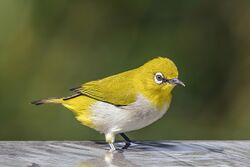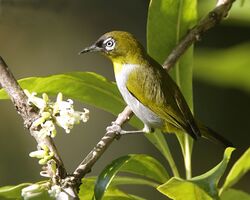Biology:Zosterops
| Zosterops | |
|---|---|

| |
| Z. palpebrosus egregius, Sri Lanka | |
| Scientific classification | |
| Domain: | Eukaryota |
| Kingdom: | Animalia |
| Phylum: | Chordata |
| Class: | Aves |
| Order: | Passeriformes |
| Family: | Zosteropidae |
| Genus: | Zosterops Vigors & Horsfield, 1827 |
| Type species | |
| Motacilla maderaspatana (Malagasy white-eye) Linnaeus, 1766
| |
| Species | |
|
See text | |
Zosterops (meaning "eye-girdle") is a genus of passerine birds containing the typical white-eyes in the white-eye family Zosteropidae. The genus has the largest number of species in the white-eye family. They occur in the Afrotropical, Indomalayan, and Australasian realms. Typical white-eyes have a length of between 8 and 15 cm (3 and 6 in). Their most characteristic feature is a conspicuous white feather ring around the eye, though some species lack it. The species in this group vary in the structural adaptations of the tongue.[1] The Zosterops [griseotinctus] group is an example of a "great speciator" inhabiting a vast area and showing a remarkable morphological differentiation on islands, some of which maybe as close as 2 km (1.2 mi) apart.[2]
Systematics
The genus Zosterops was introduced by the naturalists Nicholas Vigors and Thomas Horsfield in 1827.[3] The name combines the Ancient Greek words zōstēros "belt" or "girdle" and ōpos "eye".[4] The type species was designated as the Malagasy white-eye by René Lesson in 1828.[5][6]
The results of a series of molecular phylogenetic studies of the Zosteropidae published between 2014 and 2018 prompted a major revision of species limits, in which 10 new genera were introduced. In the reorganisation, the English names of three of the existing genera were replaced.[7][8][9][10][11]
Additionally, a study on Sri Lanka white-eyes (Zosterops ceylonensis) and Indian white-eyes (Zosterops palpebrosus) suggests that the Sri Lanka white-eye is the root species and the origin of all Zosterops species.[12] This raises questions upon the former theory of Southeast Asian origin.
Species
There are over 100 species in the genus. This includes three species (denoted by a dagger † in the list below) that have become extinct since the 16th century.[11]
- Sri Lanka white-eye (Zosterops ceylonensis)
- Yellowish white-eye (Zosterops nigrorum)
- Black-capped white-eye (Zosterops atricapilla)
- Abyssinian white-eye (Zosterops abyssinicus)
- Pale white-eye (Zosterops flavilateralis)
- Mbulu white-eye (Zosterops mbuluensis) – split from Z. poliogastrus
- Chestnut-flanked white-eye (Zosterops erythropleurus)
- Swinhoe's white-eye (Zosterops simplex) – split from Z. japonicus
- Mountain blackeye (Zosterops emiliae)
- Warbling white-eye (Zosterops japonicus) – includes Japanese white-eye and mountain white-eye
- Indian white-eye (Zosterops palpebrosus) – formerly oriental white-eye
- Lowland white-eye (Zosterops meyeni)
- † Marianne white-eye (Zosterops semiflavus)
- Karthala white-eye (Zosterops mouroniensis)
- Réunion olive white-eye (Zosterops olivaceus)
- Mauritius olive white-eye (Zosterops chloronothos)
- Réunion grey white-eye (Zosterops borbonicus)
- Mauritius grey white-eye (Zosterops mauritianus)
- Mount Cameroon speirops (Zosterops melanocephalus)
- Forest white-eye (Zosterops stenocricotus)
- Green white-eye (Zosterops stuhlmanni) – split from Z. poliogastrus
- Broad-ringed white-eye (Zosterops eurycricotus) – split from Z. poliogastrus
- Fernando Po speirops (Zosterops brunneus)
- Heuglin's white-eye (Zosterops poliogastrus) – formerly montane white-eye
- Kikuyu white-eye (Zosterops kikuyuensis)
- Socotra white-eye (Zosterops socotranus) – split from Z. abyssinicus
- Príncipe white-eye (Zosterops ficedulinus)
- Annobón white-eye (Zosterops griseovirescens)
- São Tomé white-eye (Zosterops feae)
- Black-capped speirops (Zosterops lugubris)
- Príncipe speirops (Zosterops leucophaeus)
- Taita white-eye (Zosterops silvanus)
- Northern yellow white-eye (Zosterops senegalensis) – formerly African yellow white-eye
- Orange River white-eye (Zosterops pallidus)
- South Pare white-eye (Zosterops winifredae) – split from Z. poliogastrus
- Cape white-eye (Zosterops virens)
- Southern yellow white-eye (Zosterops anderssoni) – split from Z. senegalensis
- Pemba white-eye (Zosterops vaughani)
- Seychelles white-eye (Zosterops modestus)
- Anjouan white-eye (Zosterops anjuanensis)
- Moheli white-eye (Zosterops comorensis)
- Malagasy white-eye (Zosterops maderaspatanus)
- Meratus white-eye (Zosterops meratusensis)
- Aldabra white-eye (Zosterops aldabrensis) – split from Z. maderaspatanus
- Kirk's white-eye (Zosterops kirki)
- Mayotte white-eye (Zosterops mayottensis)
- Lemon-bellied white-eye (Zosterops chloris)
- Wakatobi white-eye (Zosterops flavissimus) – split from Z. chloris
- Black-crowned white-eye (Zosterops atrifrons)
- Sangihe white-eye(Zosterops nehrkorni)
- Pale-bellied white-eye (Zosterops consobrinorum)
- Togian white-eye (Zosterops somadikartai)
- Black-ringed white-eye (Zosterops anomalus)
- Green-fronted white-eye (Zosterops minor)
- Black-fronted white-eye (Zosterops chrysolaemus) – split from Z. minor[13]
- Tagula white-eye (Zosterops meeki)
- Morotai white-eye (Zosterops dehaani) – split from Z. atriceps
- Cream-throated white-eye (Zosterops atriceps)
- Buru white-eye (Zosterops buruensis)
- Seram white-eye (Zosterops stalkeri)
- Javan white-eye (Zosterops flavus)
- Ashy-bellied white-eye (Zosterops citrinella)
- Canary white-eye (Zosterops luteus)
- Silvereye (Zosterops lateralis)
- Hume's white-eye (Zosterops auriventer) – split from Z. poliogastrus
- Sangkar white-eye (Zosterops melanurus) – split from Z. palpebrosus
- Everett's white-eye (Zosterops everetti)
- Vella Lavella white-eye (Zosterops vellalavella)
- Santa Cruz white-eye (Zosterops sanctaecrucis)
- Capped white-eye (Zosterops fuscicapilla)
- Oya Tabu white-eye (Zosterops crookshanki) – split from Z. fuscicapilla[13]
- Vanuatu white-eye (Zosterops flavifrons)
- Bare-eyed white-eye (Zosterops superciliosus)
- Sanford's white-eye (Zosterops lacertosus)
- Vanikoro white-eye (Zosterops gibbsi)
- Fiji white-eye (Zosterops explorator)
- Bismarck white-eye (Zosterops hypoxanthus)
- Biak white-eye (Zosterops mysorensis)
- Bougainville white-eye (Zosterops hamlini) – split from Z. rendovae[13]
- Guadalcanal white-eye (Zosterops oblitus) – split from Z. rendovae[13]
- Grey-throated white-eye (Zosterops rendovae)
- Olive-colored white-eye (Zosterops oleagineus)
- Dusky white-eye (Zosterops finschii)
- Grey-brown white-eye (Zosterops ponapensis)
- Kosrae white-eye (Zosterops cinereus)
- Rota white-eye (Zosterops rotensis)
- Yellow-throated white-eye (Zosterops metcalfii)
- Malaita white-eye (Zosterops stresemanni)
- Papuan white-eye (Zosterops novaeguineae)
- Ambon white-eye (Zosterops kuehni)
- Pearl-bellied white-eye (Zosterops grayi)
- Gizo white-eye (Zosterops luteirostris)
- Golden-bellied white-eye (Zosterops uropygialis)
- Ranongga white-eye (Zosterops splendidus)
- Solomons white-eye (Zosterops kulambangrae)
- Dark-eyed white-eye (Zosterops tetiparius)
- Christmas white-eye (Zosterops natalis)
- Bridled white-eye (Zosterops conspicillatus)
- Citrine white-eye (Zosterops semperi)
- Plain white-eye (Zosterops hypolais)
- Wangi Wangi white eye (Zosterops paruhbesar)[14]
- Louisiade white-eye (Zosterops griseotinctus)
- Kolombangara white-eye (Zosterops murphyi)
- Large Lifou white-eye (Zosterops inornatus)
- † White-chested white-eye (Zosterops albogularis)
- Samoan white-eye (Zosterops samoensis)
- † Robust white-eye (Zosterops strenuus)
- Slender-billed white-eye (Zosterops tenuirostris)
- Small Lifou white-eye (Zosterops minutus)
- Green-backed white-eye (Zosterops xanthochroa)
- Rennell white-eye (Zosterops rennellianus)
References
- ↑ Moreau, R. E.; Perrins, M.; Hughes, J. T. (1969). "Tongues of the Zosteropidae (white-eyes)". Ardea 57: 29–47.
- ↑ Moyle, R. G.; Filardi, C. E.; Smith, C. E.; Diamond, J. (2009). "Explosive Pleistocene diversification and hemispheric expansion of a "great speciator"". Proceedings of the National Academy of Sciences 106 (6): 1863–1868. doi:10.1073/pnas.0809861105. PMID 19181851. Bibcode: 2009PNAS..106.1863M.
- ↑ Vigors, Nicholas Aylward; Horsfield, Thomas (1827). "Australian birds in the collection of the Linnean Society; with an attempt at arranging them according to their natural affinities" (in en, la). Transactions of the Linnean Society of London 15 (1): 170–334 [234]. doi:10.1111/j.1095-8339.1826.tb00115.x. https://biodiversitylibrary.org/page/778483. The title page is dated 1826.
- ↑ Jobling, James A. (2010). The Helm Dictionary of Scientific Bird Names. London: Christopher Helm. p. 414. ISBN 978-1-4081-2501-4. https://archive.org/stream/Helm_Dictionary_of_Scientific_Bird_Names_by_James_A._Jobling#page/n414/mode/1up.
- ↑ Lesson, René P. (1828) (in French). Manuel d'ornithologie, ou Description des genres et des principales espèces d'oiseaux. 1. Paris: Roret. p. 286. https://www.biodiversitylibrary.org/page/55490369.
- ↑ Paynter, Raymond A. Jr, ed (1986). Check-list of Birds of the World. 12. Cambridge, Massachusetts: Museum of Comparative Zoology. p. 290. https://biodiversitylibrary.org/page/14482407.
- ↑ Cox, S.C.; Prys-Jones, R.P.; Habel, J.C.; Amakobe, B.A.; Day, J.J. (2014). "Niche divergence promotes rapid diversification of East African sky island white-eyes (Aves: Zosteropidae)". Molecular Ecology 23 (16): 4103–4118. doi:10.1111/mec.12840. PMID 24954273.
- ↑ Wells, D.R. (2017). "Zosterops white-eyes in continental South-East Asia. 1: proposed refinements to the regional definition of Oriental White-eye Z. palpebrosus". Bulletin of the British Ornithologists' Club 137 (2): 100–109. doi:10.25226/bboc.v137i2.2017.a12.
- ↑ Wells, D.R. (2017). "Zosterops white-eyes in continental South-East Asia. 2: what is Zosterops auriventer Hume?". Bulletin of the British Ornithologists' Club 137 (2): 110–117. doi:10.25226/bboc.v137i2.2017.a13.
- ↑ Lim, B.T.M.; Sadanandan, K.R.; Dingle, C.; Leung, Y.Y.; Prawiradilaga, D.M.; Irham, M.; Ashari, H.; Lee, J.G.H. et al. (2018). "Molecular evidence suggests radical revision of species limits in the great speciator white‑eye genus Zosterops". Journal of Ornithology 160: 1–16. doi:10.1007/s10336-018-1583-7.
- ↑ 11.0 11.1 Gill, Frank; Donsker, David; Rasmussen, Pamela, eds (July 2021). "Sylviid babblers, parrotbills, white-eyes". IOC World Bird List Version 11.2. International Ornithologists' Union. https://www.worldbirdnames.org/bow/sylvias/.
- ↑ Wickramasinghe, Nelum; Robin, V. V.; Ramakrishnan, Uma; Reddy, Sushma; Seneviratne, Sampath S. (2017). "Non-sister Sri Lankan white-eyes (genus Zosterops) are a result of independent colonizations". PLOS ONE 12 (8): e0181441. doi:10.1371/journal.pone.0181441. PMID 28792950.
- ↑ 13.0 13.1 13.2 13.3 "Species Updates – IOC World Bird List" (in en-US). https://www.worldbirdnames.org/new/updates/species-updates/.
- ↑ Anderson, Natali (2022-10-21). "Newly-Described Bird Species is Endemic to Indonesian Island | Sci.News" (in en-US). https://www.sci.news/biology/zosterops-paruhbesar-11318.html.
External links
| Wikisource has the text of the 1911 Encyclopædia Britannica article Zosterops. |
- Zosterops photos & videos on the Internet Bird Collection
Wikidata ☰ Q226900 entry
 |




